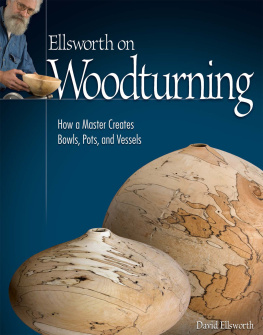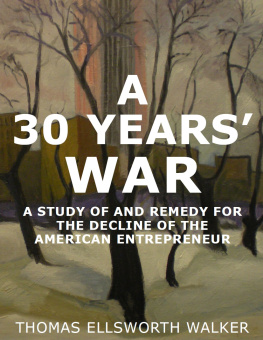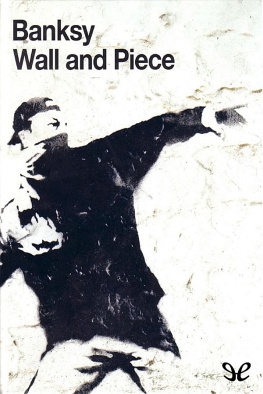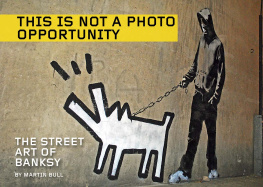Will Ellsworth-Jones - Banksy: The Man Behind the Wall
Here you can read online Will Ellsworth-Jones - Banksy: The Man Behind the Wall full text of the book (entire story) in english for free. Download pdf and epub, get meaning, cover and reviews about this ebook. year: 2012, publisher: Aurum Press Ltd, genre: Detective and thriller. Description of the work, (preface) as well as reviews are available. Best literature library LitArk.com created for fans of good reading and offers a wide selection of genres:
Romance novel
Science fiction
Adventure
Detective
Science
History
Home and family
Prose
Art
Politics
Computer
Non-fiction
Religion
Business
Children
Humor
Choose a favorite category and find really read worthwhile books. Enjoy immersion in the world of imagination, feel the emotions of the characters or learn something new for yourself, make an fascinating discovery.
- Book:Banksy: The Man Behind the Wall
- Author:
- Publisher:Aurum Press Ltd
- Genre:
- Year:2012
- Rating:4 / 5
- Favourites:Add to favourites
- Your mark:
- 80
- 1
- 2
- 3
- 4
- 5
Banksy: The Man Behind the Wall: summary, description and annotation
We offer to read an annotation, description, summary or preface (depends on what the author of the book "Banksy: The Man Behind the Wall" wrote himself). If you haven't found the necessary information about the book — write in the comments, we will try to find it.
Banksy: The Man Behind the Wall — read online for free the complete book (whole text) full work
Below is the text of the book, divided by pages. System saving the place of the last page read, allows you to conveniently read the book "Banksy: The Man Behind the Wall" online for free, without having to search again every time where you left off. Put a bookmark, and you can go to the page where you finished reading at any time.
Font size:
Interval:
Bookmark:


For Lara and Daniel and in memory of Barbara
F irst to my wife Barbara who died in February 2012. Despite extended stays in hospital and all kinds of pain when out of hospital she was determined that none of her trials and tribulations were going to stop this book being written. Sometimes in hospital she worried much more about whether I had done enough writing that day before coming to see her than she did about her own far more pressing problems. In times of despair, particularly early on when it seemed it was going to be impossible to get through the wall of silence that surrounds Banksy, and I doubted if I would ever finish the book, I told myself that I could not conceive of letting her down.
Next my thanks to Graham Coster, Publisher at Aurum Press, who had the original idea for this book, helped me develop it and was a very understanding shoulder to lean on during all the usual and unusual ups and downs.
There are a few people who were of considerable help to me but who would not thank me at all if I named them here because they would then be cast out from the Banksy magic circle. But they know who they are many thanks and thanks too to all those who did help and are named in the book.
My thanks to three people who showed great patience in initiating me into the world of graffiti. First Nico Yates, a young graffiti artist who writes under the name of Spico who, over breakfast one morning in a caf in Deptford, gave me my first long lesson in graffiti. Thanks too to David Samuel and John Nation who, with similar patience, expanded this lesson on the streets of London and Bristol.
My thanks as always to Don Berry who gave me key advice at awkward moments along the road and then made the first edit of the manuscript as always suggesting many changes for the better. My thanks too to Bernie Angopa, Drusilla Beyfus, Mick Brown, Jessamy Calkin, Gary Cochran, Jon Connell, Carolynne Ellis-Jones, David Galloway, Gail Gregg, Cathy Giles, Jonathan Giles, Henry Greaves, Nick Greaves, Rory and Michael McHugh, Vicki Reid, Mern Palmer-Smith, Francesca Ryan, Claire Scobie, Robin Smith, Emma Soames and Angela Swan who all helped in various ways. The mistakes, however, are all mine.
H e is the outlaw who has been dragged reluctantly, but relentlessly, ever closer to the art establishment.
He is the artist who mocked museums and art galleries alike. Yet he chose to mount his first major exhibition in one of the crustiest museums imaginable amidst the stuffed animals and the antique pianos of Bristol City Museum and Art Gallery and made a huge success of it.
When, in 2010, Time magazine selected him for its list of 100 most influential people in the world, along with the likes of Barack Obama, Apples Steve Jobs and Lady Gaga, he supplied a picture of himself with a paper bag (recyclable of course) over his head. For he is an artist unique in the twenty-first century: famous but unknown.
He claims he needs this anonymity to protect himself from the forces of law and order. This was true in the past, but at this stage in his career most cities would welcome a new Banksy on the wall. The argument would be how best to preserve it, not how to lock up its creator.
This book does not attempt to unmask him. Tales of scuttling around his home town of Bristol trying to convince childhood friends to reveal his identity would not make for very interesting reading. More important is the fact that fans, followers and even those who are just vaguely aware he exists, dont want to know who he is. The New Statesman critic who derides it all as ostentatious anonymity is very much in the minority. We all enjoy the mystery of the man who has somehow managed to get himself described as Robin Hood even though he is hardly robbing the rich to feed the poor.
What this book does do, however, is to follow his upward spiral from the outlaw just one of many spraying the walls of Bristol in the 1990s to the artist whose work commands hundreds of thousands of pounds in the auction houses of Britain and America. The outsider who has become an insider.
It has not been an easy voyage. Pest Control, the appropriately named organisation set up to authenticate the real Banksy artwork from the fake, is also involved in protecting him from outsiders. Pest Control uses everything from a tightly drawn up legal contract to a carefully timed phone call from the man himself where necessary to maintain its control.
Hiding behind a paper bag or, more commonly, email, Banksy wants to protect and preserve his own narrative and he does this very well. Pest Control has asked that this book be marked unofficial to avoid any doubt with the public that the book might be sanctioned by the artist and, yes, it is completely unofficial utterly unauthorised. It is perhaps ironic that a graffiti artist appears to be trying to authorise the way people both think and write about him. Which is sad, for his work speaks for itself. His unique talent puts him at the head of a whole new movement in the world of art: street art. A technically skilled artist who has literally taken art into places it has never been before, he marries this skill with an acute eye for the world around us. He is both artist and social commentator with the humour of a great cartoonist.
Inevitably what comes with all this is a certain amount of baggage. There is the paranoia, which if anything has grown over the years, and then of course there is the money. He says, I dont make as much money as people think, and it is true, he is not yet in the Damien Hirst money-making bracket, but money he certainly makes. In his earlier days, when his prices suddenly started to rocket upwards, often it was not Banksy who was making the huge amounts that captured the headlines but his fans. Usually they were from his home town of Bristol, fans who had bought a painting for a couple of hundred quid not as an investment but simply because they liked it and were selling it a few years later for thousands. For a short time it was that elusive commodity called peoples art. But when the art investors moved in the money started to flow to Banksy himself.
He accuses others of being capitalist but, despite giving away some pictures for charity, funding events for other graffiti artists, trying to sell prints at a reasonable price only to see them more than double in value on eBay, he too is a capitalist albeit a reluctant one. With all the compromises and fudges that this entails, this is the side of life that he is most uneasy in dealing with.
With his success comes the inevitable envy and accusations of being a sell-out. Certainly there are many people in the street art world who criticise him, but almost universally, whether they be gallery owners or street artists who have found a market for their work, they admit, if sometimes a little grudgingly, Without Banksy I wouldnt be here.
For he is the standard bearer for a whole new movement in art, whether its practitioners be pure graffiti writers, stencil artists like himself or even artists who crochet their own graffiti. It is a movement which has sprung off the streets and into a much wider public consciousness. In an emailed interview to publicise his film Exit Through the Gift Shop, Banksy suggested: Theres a whole new audience out there, and its never been easier to sell it, particularly at the lower levels. You dont have to go to college, drag round a portfolio, mail off transparencies to snooty galleries or sleep with someone powerful. All you need now is a few ideas and a broadband connection. This is the first time the essentially bourgeois world of art has belonged to the people. We need to make it count.
Next pageFont size:
Interval:
Bookmark:
Similar books «Banksy: The Man Behind the Wall»
Look at similar books to Banksy: The Man Behind the Wall. We have selected literature similar in name and meaning in the hope of providing readers with more options to find new, interesting, not yet read works.
Discussion, reviews of the book Banksy: The Man Behind the Wall and just readers' own opinions. Leave your comments, write what you think about the work, its meaning or the main characters. Specify what exactly you liked and what you didn't like, and why you think so.











